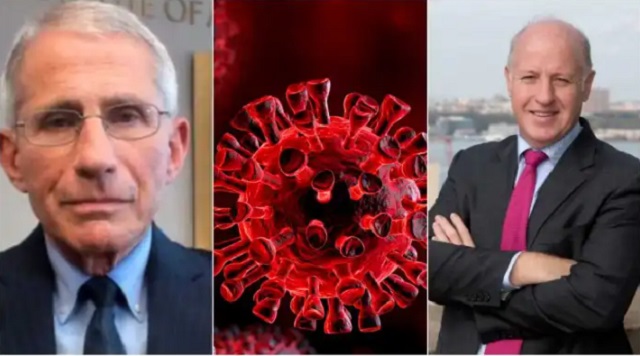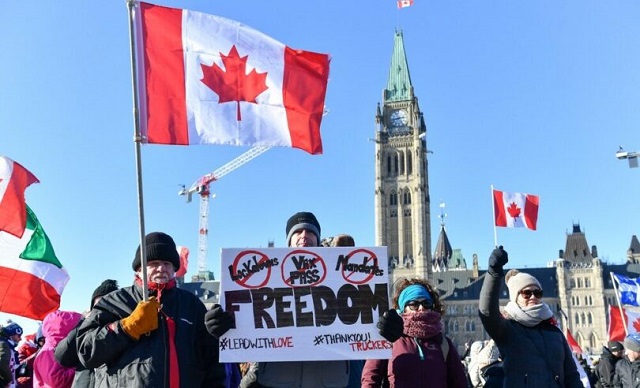Bruce Dowbiggin
Auston City Limits: The Maple Leafs Go Cap In Hand
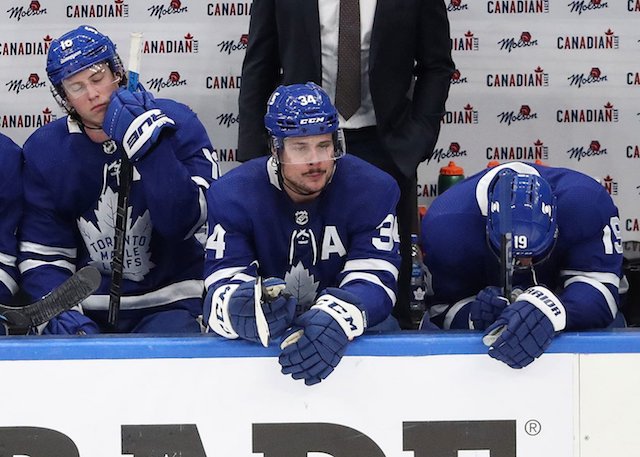
Yet another long national nightmare has passed for Toronto Maple Leafs Nation. After a prolonged summer silence from star forward Auston Matthews about his intentions for Toronto the mustachioed sniper has agreed to a four-year, $13.25 M. per-season extension with the team (beginning in 2025).
This news resonates at a number of levels from the team to the NHL head office. 1) While Matthews has yet to prove he can lead the Leafs anywhere but a golf course come May, he remains their best hope for any assault on the 56-year Stanley Cup drought. It might be a stretch to say the 40-plus-goal scorer in the regular season led them to their first postseason series win in April against Tampa. Patricia Bergeron he ain’t. But he didn’t hold them back, either. Not every Leafs star can say that.
He’s at a point (25) where a number of NHL stars have morphed from stats producers to win producers. Bryan Trottier, Steve Yzerman, Joe Sakic and Vincent Lecavalier are a sampling of guys who added leadership their tool box in mid-career and went on to multiple Cups. We will see if Auston does likewise.

2) Matthews’ decision to remain in a Canadian city is a huge relief for the league which has recently seen American stars abandon or ignore Canadian cities for the lure of their home country. Indeed, Matthews would likely have gotten all the perks of this deal elsewhere— plus the anonymity of being an NHL player in a city obsessed by the NFL, NBA or MLB. He could’ve maxxed his take-home pay going to one of the NHL teams benefitting from no-state-income-tax. And the NHL would get a huge problem with Canadian fans.
As Canada’s economy wobbles and players have a choice on lifestyle, Matthews’ decision to live in the Toronto fish bowl means that at least one CDN team is relevant. And, let’s be honest, he has a chance of winning the Cup that he wouldn’t in six other CDN teams. If that doesn’t pan out his contract is movable should he desire to move on before 2028.
3) Speaking of relief, getting the deal done is a break for new Toronto GM Brad Treliving. It was he who, as Flames GM, had to negotiate the escape of Americans Johnny Gaudreau and Matthew Tkachuk from Calgary last summer. Had he not been able to retain Matthews in Canada’s largest market it would have not been a job enhancer. Now, he has to find a way to squeeze all Toronto’s glamour boys— hello William Nylander— under the cap and leave room for what they still need. Good luck, Brad.

4) Matthews’ commitment to Toronto means that a number of teams who’ve been delaying bold moves and hoarding trade bait in anticipation of his potential trade or UFA market can now move to Plan B. There were a number of U.S. teams poised to offer the Leafs the moon and stars— NHL version— at the trade deadline or to sign him next summer. This should now signal some activity by teams anxious to deal.
Ironically, the Leafs used to be that team waiting for a Toronto Moses to emerge in the UFA market. Remember Brian Burke’s unseemly longing for Steven Stamkos? Even when they got their local guy in John Tavares, the Islanders star was past his peak and has proved a millstone under the Toronto salary cap. This time they get a star in his peak years.

5) Matthews’ league-leading benchmark of $13.25 M. over just four years allows the NHL salary grid to fall in place behind him as the salary cap takes a bump in 2024-25. His deal will be the comparison for the next superstar contract that enters the unlimited FA portal in the future— although his max salary may chafe some stars who match Matthews’ production but have taken their teams deep into playoffs or winning a Cup. Don’t they deserve more? The expected rise in the league cap over the four years of the Matthews deal may help assuage that.
6) Finally— and most amusing— has been the response from hockey sweats to Matthews getting $13.25 M. For four years? To this crew who talk lovingly about The Game, this seems an awful lot to pay a guy for playing a boy’s game. That much? This just in, Matthews is criminally underpaid as one of the Top 10 players in a modern sports league.
The dizzying $13.25 as NHL No. 1 would make him the 113th highest-paid player in the NBA, the 103rd highest-paid player in the MLB and the 88th highest-paid player in the NFL. As one perspective, Toronto-born Shai Gilgeous-Alexander of OKC Thunder— now starring for Canada’s national team— pays about $13.25M per year in income tax.

Sure, there are differences among the revenues of the Big Four pro Leagues But, as we’ve written extensively, the @NHLPA sold out its stars in the 2004-05 CBA negotiations to protect average players and grinders. (Actually, it was a small group of stars pushed by their agents to stab Bob Goodenow’s strategy in the back.) They like to mock the product in CBA talks.
Limiting the maximum contracts to 20 percent of the cap allows the league to have higher minimum and median salaries than NFL and MLB. (Hands up those people who buy tickets or digital packages to see the third line and fifth defenceman?) And pay lip service that it’s still Don Cherry’s Original Six league. With its cozy business plan there’s been little incentive to push the NHL’s business model beyond more expansion.
Also of note, if NHL doesn’t make its revenue target under this #CBA Matthews and the other players will have money clawed back in escrow. Great deal, huh? None of the other leagues has escrow, a device thought up by an NYC law firm and foisted on gullible NHL stars in secret meetings to break the 2004-05 lockout. Everything since then has been pantomime labour negotiations.
So good luck, Leafs fans. Enjoy Matthews and the star-spangled Toronto lineup. Things could change with the same guys making more money. But don’t hold your breath.

Sign up today for Not The Public Broadcaster newsletters. Hot takes/ cool slants on sports and current affairs. Have the latest columns delivered to your mail box. Tell your friends to join, too. Always provocative, always independent.
Bruce Dowbiggin @dowbboy is the editor of Not The Public Broadcaster A two-time winner of the Gemini Award as Canada’s top television sports broadcaster, he’s a regular contributor to Sirius XM Canada Talks Ch. 167. Inexact Science: The Six Most Compelling Draft Years In NHL History, his new book with his son Evan, was voted the seventh-best professional hockey book of all time by bookauthority.org . His 2004 book Money Players was voted sixth best on the same list, and is available via http://brucedowbigginbooks.ca/book-personalaccount.aspx
Bruce Dowbiggin
Lather, Rinse, Repeat: Recycling Coaches In The NHL
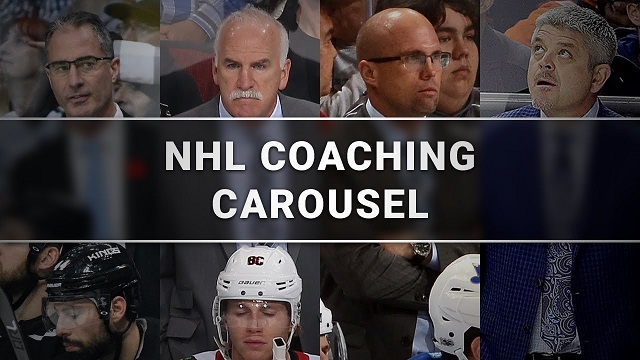
“The world will ask you who you are, and if you do not know, the world will tell you.” Carl Jung
As long as you’re willing to re-locate frequently the job of NHL head coach has a fair degree of job security. Even when you get fired it seems there’s a ready appetite in some other town for a skill set you have just failed at.
Latest evidence that failure has an I and U in it: Having canned Sheldon Keefe after a lengthy (note: sarcasm) five years at the helm of the Toronto Maple Leafs, club management scoured the bushes to find former player Craig “Chief” Berube, who has previously hung his coaching shingle in Philadelphia and St. Louis, where he won a Stanley Cup as an interim coach.

Chief wasn’t the glamour name (we were praying for Bruce Boudreau.). If the idea is how do the Leafs motivate their four mega-millionaires, he’s more like Mike Babcock than Sheldon Keefe. He won’t look at players’ cell phones, but he will give them that old-time religion. Knowing Chief from his Calgary days we’d say he can probably take the Toronto fishbowl.
(For those with long Leafs’ memories Berube was part of a famous trade in 1992 to which we devote an entire chapter in our new book Deal With It. He went west to Calgary while Doug Gilmour headed east to Toronto in the massive 10-man trade. While the Leafs “won” the trade, only the maligned Gary Leeman and journeyman Jamie Macoun won Cups– for teams other than Calgary and Toronto.)

But we digress. Sometimes it seems that NHL teams would rather lose with a known commodity than win with someone bold and unconventional behind the bench. While almost 30 percent of NHL players are European there have only been two European heads coaches, none in the past 20 years. Why? NHL owners are risk averse. And the league is a fraternity of forgiveness for guys you played junior with.
A brief ramble through the 2023-24 coaching roster shows several peripatetic bench bosses, led by the inimitable John Tortarella, who wore out his welcome in Vancouver, Tampa Bay, NY Rangers and Columbus before Philly curiously decided he had something left to offer. Let’s also not forget Lindy Ruff, who was pink slipped in Buffalo, Dallas, New Jersey and the NY Rangers— and now has been resurrected in Buffalo as a “fresh voice”.
Some retreads are getting results. Peter Laviolette has the Rangers into the third-round of the 2024 postseason, after gigs in Carolina, Philadelphia, Nashville, Washington (pause for breath) and the NY Islanders. Paul Maurice, currently guiding Florida in the playoffs, has had two stints with Carolina, plus Toronto and Winnipeg. Peter DeBoer, whose Dallas Stars are odd-on faves to with the 2024 Cup, has also coached Florida, San Jose, New Jersey and Vegas.
You want more? Rick Tocchet was head coach in Arizona and Tampa Bay before getting the perch in Vancouver. Travis Green, newly hired in Ottawa, has previously been found wanting in Vancouver and New Jersey. We could go on.

The king of the coach-for-life carousel is the just-retired Rick Bowness who finally called it a day in Winnipeg after the Jets were eliminated this spring. How long has Bones been knocking around? He was the coach of the expansion Ottawa Senators in 1992, one the worst five teams ever by NHL standards. Wonderful man who also spent stints as an assistant in cities in 30-plus years around the continent.
There are more. Sitting in the green room, polishing their pregame speeches are the well- travelled Boudreau, Dallas Eakins, Gerard Gallant, Todd McLellan, Claude Julien and Mike Yeo. Heaven forbid someone might still ask one of the Sutters to saddle up again. Brian (St. Louis, Chicago, Boston, Calgary), Darryl (Calgary, L.A., Anaheim, San Jose and Calgary again) and Brent (Calgary, New Jersey) have been perennial NHL coaching prospects for decades.

So take, heart, Sheldon Keefe. Joining Keefe in looking for a rebound job are Scott Arniel, Jeff Blashill, Jeremy Colliton, Kevin Dineen, Phil Housley, Kirk Muller, Davis Payne, Todd Reirden, Joe Sacco, Brad Shaw, Geoff Ward and Trent Yawney. Good company.
Don’t cry too hard for these coaching candidates. Unless they have years left on contract (Keefe has two) most wait out the time between head-coaching stints by accepting assistant-coach positions. The ranks of assistants contain a second tier of talent, also ready to go at a moment’s notice.
There are a scant few who’ve hung on in one town. Jon Cooper has been in Tampa since 2013, a Methuselah stint in today’s terms. Rod Brind’Amour has managed to avoid the chop in Carolina since 2018. But the reality is that, since the start off the 2023-24 season alone, there have been 13 head-coaching changes in the NHL. Go back to January of 2023, and 19 of the league’s 32 teams have changed coaches.
Which brings us back to the original idea: “Is there no one in international hockey who knows anything?” We won’t profess to be coaching talent scouts, but the idea that no one working outside North America can meet the job description better than some— if not most—of the coaches mentioned above beggars the imagination.
One final note: If you’re looking for an explanation of the coaching carousel and its recent frequency, look no further than Gary Bettman and his salary cap obsession. By forcing a hard cap on teams he’s concentrated the money— and the power— on a few players per team. When a coach is pitted against his stars it’s a no-win proposition.
The Leafs stars used their power to get Babcock fired. And it’s been repeated on other teams. While Keefe didn’t lose his Core Four he also couldn’t get them to win in the postseason. For that he got the chop— and a premium place in the next coaching carousel.
Bruce Dowbiggin @dowbboy is the publisher of Not The Public Broadcaster A two-time winner of the Gemini Award as Canada’s top television sports broadcaster, he’s a regular contributor to Sirius XM Canada Talks Ch. 167. Now for pre-order, new from the team of Evan & Bruce Dowbiggin— Deal With It: The Trades That Stunned The NHL & Changed Hockey. From Espo to Boston in 1967 to Gretz in L.A. in 1988 to Patrick Roy leaving Montreal in 1995, the stories behind the story. Launching in paperback and Kindle on #Amazon this week. Destined to be a hockey best seller. https://www.amazon.ca/Deal-Trades-Stunned-Changed-Hockey-ebook/dp/B0D236NB35/
Bruce Dowbiggin
Jerry Came to See The Babies. And They Walked Out On Him
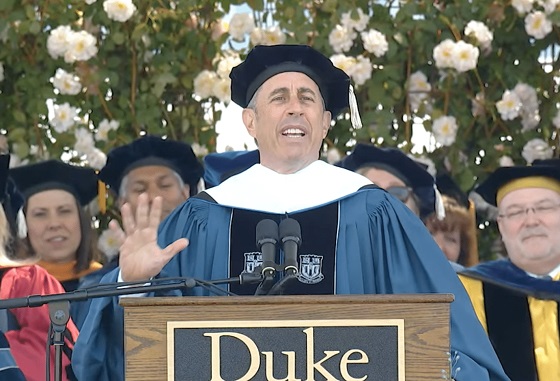
Cometh the hour, cometh the comedian. Or, you can learn a lot about a demographic by what makes them laugh.
The legacy/ lunacy media schvitzed itself over a few furious sociology majors and look-at-me drama queens walking out on Jerry Seinfeld’s commencement address at Duke University last weekend. But the significance of his admission that he was 70 was probably far more newsworthy to those now in retirement, binge-watching his eponymous TV series on one of those down-the-dial channels.
If we had a dollar for every Boomer who said, “Seinfeld is 70?” while watching the address we’d be Warren-Buffett-rich this morning. He doesn’t look like any 70 year olds we know. Fifty? Maybe. But listening to his familiar delivery, the mocking on his honorary degree costume, it was easy to believe that we, too, are much younger than our blood-thinner prescriptions say.
It also pointed out the evolution of Boomers’ comedic tastes. When they came of age in the late 1960s/ early 1970s Woody Allen best profiled as his generation’s comedic muse. With a dozen classic movies ranging from What’s New Pussycat (1965) through Play It Again Sam (1972) to Annie Hall (1977) Allen’s self-deprecating nebbish captured the romantic/ridiculous self-image of Boomers with “Some drink deeply from the river of knowledge. Others only gargle”.

The neurotic, insecure Allen then decided to become Ingmar Bergman, and Boomers— now assembling jobs, children and first spouses— moved on. But for that 12-year span the bedraggled standup comedian was the go-to with lines like “Just because you’re paranoid doesn’t mean they aren’t out to get you” and “The only love that lasts is unrequited love.”
Woody’s pointed contemporary political references in those years were few (conflating “D’you” for “Jew” with Tony Roberts in Manhattan) and self-deflating (see Annie Hall). His most prominent political jabs were framed in absurdist material like Love And Death and Bananas. Culturally he was merciless but affectionate about his Brooklyn upbringing. In short his were perfect date movies for Boomers seeking love to advertise their pretensions.
Flash forward from Woody to Seinfeld (created with Larry David) which was anti-romantic in the extreme. The characters were sociopaths. The situations often cringeworthy. The 24-minute formula harkened back to Lucy and the Honeymooners. And while schlock like Friends trod the same ground it was Seinfeld that somehow captured the Boomer zeitgeist.
Why? Boomers going through middle age were too disillusioned with how life was turning out to romanticize anymore. The self-obsessed characters were people they knew from work, school and dealing with government. Smirking Bill Clinton was the face of an era. “When we did my show in the 90s, it was so easy to make fun of things. It was so easy,” Seinfeld told Amy Schumer.
Significantly, Seinfeld the Show was cultural. Or quasi-cultural. It was never about politics per se. It was about the people who thwart you in life. Whose vanity ruins your plans from school days. Who go 50 mph in the left lane. “When is Jerry going to see the baby?” It rarely challenged its fans on an emotional level. It was mostly about navigating madness.
And often about the most mundane elements of life. The address on the weekend contained The Seinfeld Doctrine of Lowered Expectations. “It’s easy to fall in love with people. I suggest falling in love with anything and everything, every chance you get. Fall in love with your coffee, your sneakers, your blue zone parking space. I’ve had a lot of fun in life falling in love with stupid, meaningless physical objects.
“The object I love the most is the clear-barrel Bic pen — $1.29 for a box of 10. I can fall in love with a car turn signal switch that has a nice feel to it, a pizza crust that collapses with just the right amount of pressure. I have truly spent my life focusing on the smallest things imaginable, completely oblivious to all the big issues of living.”
Reaching across the generations Seinfeld delivered Dad jokes and bromides to kids who education probably cost $100 K a year. “I think it is also wonderful that you care so much about not hurting other people’s feelings in the million and one ways we all do that,” he said. Then he explained why that might be a fruitless pursuit. Not in Curb Your Enthusiasm darkness. But sobering.
That’s why it was in character for him to let the furious demonstrators depart at Duke without comment. So was appearing at Duke, the Ivy League of Tobacco Road, founded by the people who made jillions selling nicotine. And why he let them garb him like Thomas Cromwell in the absurd 16th century cape and hat so he could score few laughs.

Because laughter is his means of dealing with jerks like the outbound Hamas crowd. “What I need to tell you as a comedian: Do not lose your sense of humour. You can have no idea at this point in your life how much you are going to need it to get through. Not enough of life makes sense for you to be able to survive it without humour.”
Yes, He has been vocal lately about the effect of political correctness ruining TV comedy. Drawing flak from former friends and fans who are in the Biden re-education camps at the moment. But his annoyance at ruining an art form far outweighed any complaints about Covid and Ukraine.
As opposed to the nihilism of his former partner David, his insouciance and comic patter represent an antidote for where most of his original fans are at the moment. Woody Allen, their former idol, is now seen as a pedo and a failed nouveau vage auteur. Disillusioned with virus lies, electoral shenanigans and soaring prices, Boomers on a pension are unanchored, floating through what used to be North American society (when only women had babies).
In fact, Boomer spectators watching Seinfeld’s 17-minute speech maybe summed it up for themselves by recalling the Seinfeld mantra, “It was a show about nothing.” And they’d be right. Jerry is the man for those times.
Bruce Dowbiggin @dowbboy is the publisher of Not The Public Broadcaster A two-time winner of the Gemini Award as Canada’s top television sports broadcaster, he’s a regular contributor to Sirius XM Canada Talks Ch. 167. Now for pre-order, new from the team of Evan & Bruce Dowbiggin . Deal With It: The Trades That Stunned The NHL & Changed Hockey. From Espo to Boston in 1967 to Gretz in L.A. in 1988 to Patrick Roy leaving Montreal in 1995, the stories behind the story. Launching in paperback and Kindle on #Amazon this week. Destined to be a hockey best seller. https://www.amazon.ca/Deal-Trades-Stunned-Changed-Hockey-ebook/dp/B0D236NB35/
-
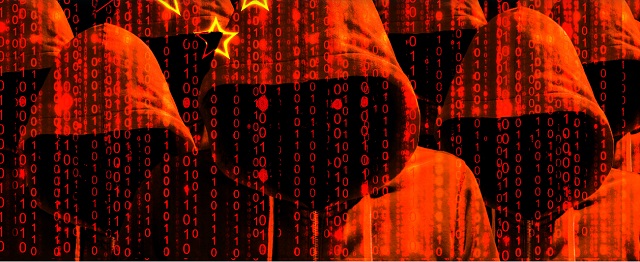
 COVID-192 days ago
COVID-192 days agoThe Vials and the Damage Done: Canada’s National Microbiology Laboratory Scandal, Part II
-

 Censorship Industrial Complex1 day ago
Censorship Industrial Complex1 day agoAustralia passes digital ID bill, raising fears of government surveillance without accountability
-

 Bruce Dowbiggin14 hours ago
Bruce Dowbiggin14 hours agoLather, Rinse, Repeat: Recycling Coaches In The NHL
-

 DEI13 hours ago
DEI13 hours agoLawmakers press investigation into DEI agenda at the Pentagon
-

 Automotive6 hours ago
Automotive6 hours agoThe EV battery ‘catch-22’
-
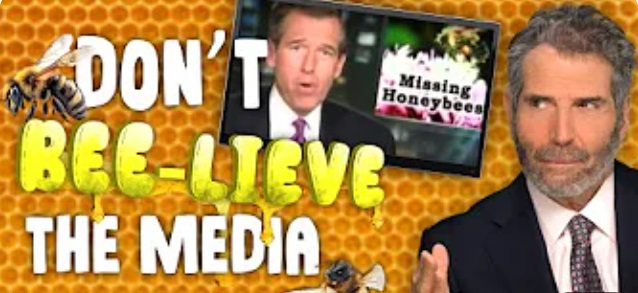
 Food4 hours ago
Food4 hours agoThe Bee-pocalypse: Another Scare Story the Media Got Wrong
-

 Brownstone Institute2 days ago
Brownstone Institute2 days agoEnough With These Dangerous Calculations
-
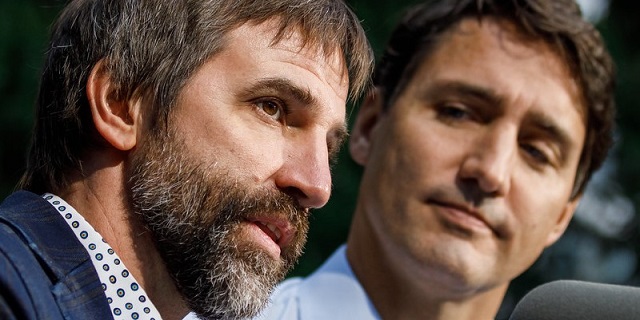
 Alberta3 hours ago
Alberta3 hours agoFree Alberta Strategy petition demanding PM Trudeau fire Steven Guilbeault passes 13,000 signatures






